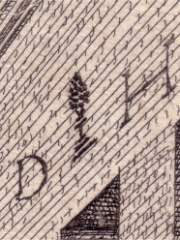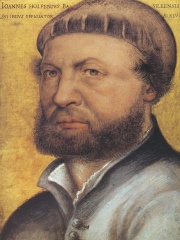
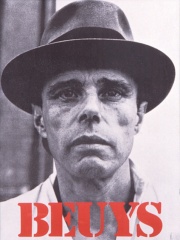
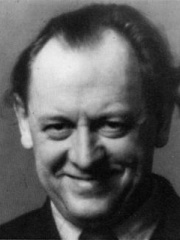
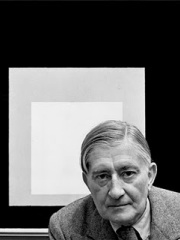
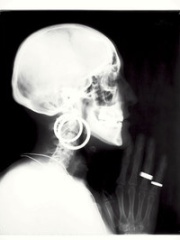
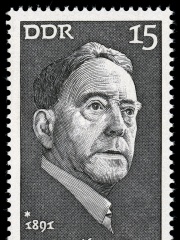
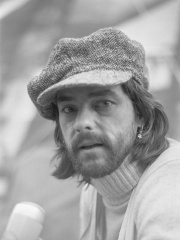
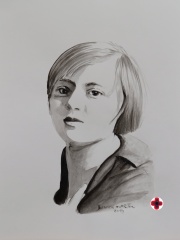
The Most Famous
ARTISTS from Germany
Top 10
The following people are considered by Pantheon to be the top 10 most legendary German Artists of all time. This list of famous German Artists is sorted by HPI (Historical Popularity Index), a metric that aggregates information on a biography's online popularity. Visit the rankings page to view the entire list of German Artists.

1. Hans Holbein the Younger (1497 - 1545)
With an HPI of 75.75, Hans Holbein the Younger is the most famous German Artist. His biography has been translated into 65 different languages on wikipedia.
Hans Holbein the Younger (UK: HOL-byne, US: HOHL-byne, HAWL-; German: Hans Holbein der Jüngere; c. 1497 – between 7 October and 29 November 1543) was a German-Swiss painter and printmaker who worked in a Northern Renaissance style, and is considered one of the greatest portraitists of the 16th century. He also produced religious art, satire, and Reformation propaganda, and he made a significant contribution to the history of book design. He is called "the Younger" to distinguish him from his father Hans Holbein the Elder, an accomplished painter of the Late Gothic school. Holbein was born in Augsburg but worked mainly in Basel as a young artist. At first, he painted murals and religious works, and designed stained glass windows and illustrations for books from the printer Johann Froben. He also painted an occasional portrait, making his international mark with portraits of humanist Desiderius Erasmus. When the Reformation reached Basel, Holbein worked for reformist clients while continuing to serve traditional religious patrons. His Late Gothic style was enriched by artistic trends in Italy, France, and the Netherlands, as well as by Renaissance humanism. The result was a combined aesthetic uniquely his own. Holbein travelled to England in 1526 in search of work with a recommendation from Erasmus. He was welcomed into the humanist circle of Thomas More, where he quickly built a high reputation. He returned to Basel for four years, then resumed his career in England in 1532 under the patronage of Anne Boleyn and Thomas Cromwell. By 1535, he was King's Painter to Henry VIII. In this role, he produced portraits and festive decorations, as well as designs for jewellery, plate, and other precious objects. His portraits of the royal family and nobles are a record of the court in the years when Henry was asserting his supremacy over the Church of England. Holbein's art was prized from early in his career. French poet and reformer Nicholas Bourbon (the elder) dubbed him "the Apelles of our time", a typical accolade at the time. Holbein has also been described as a great "one-off" in art history since he founded no school. Some of his work was lost after his death, but much was collected and he was recognized among the great portrait masters by the 19th century. Recent exhibitions have also highlighted his versatility. He created designs ranging from intricate jewellery to monumental frescoes. Holbein's art has sometimes been called realist, since he drew and painted with a rare precision. His portraits were renowned in their time for their likeness, and it is through his eyes that many famous figures of his day are pictured today, such as Erasmus and More. He was never content with outward appearance, however; he embedded layers of symbolism, allusion, and paradox in his art, to the lasting fascination of scholars. In the view of art historian Ellis Waterhouse, his portraiture "remains unsurpassed for sureness and economy of statement, penetration into character, and a combined richness and purity of style."

2. Joseph Beuys (1921 - 1986)
With an HPI of 73.86, Joseph Beuys is the 2nd most famous German Artist. His biography has been translated into 51 different languages.
Joseph Heinrich Beuys ( BOYSS; German: [ˈjoːzɛf ˈbɔʏs]; 12 May 1921 – 23 January 1986) was a German artist, teacher, performance artist, and art theorist whose work reflected concepts of humanism and sociology. With Heinrich Böll, Johannes Stüttgen, Caroline Tisdall, Robert McDowell, and Enrico Wolleb, Beuys created the Free International University for Creativity & Interdisciplinary Research (FIU). Through his talks and performances, he also formed The Party for Animals and The Organisation for Direct Democracy. He was a member of a Dadaist art movement Fluxus and singularly inspirational in developing of Performance Art, called Kunst Aktionen, alongside Wiener Aktionismus that Allan Kaprow and Carolee Schneemann termed Art Happenings. According to his biographer Reinhard Ermen, he can be seen as the “ideal antagonist” of Andy Warhol.. Beuys was professor at the Kunstakademie Düsseldorf from 1961 until 1972. He was a founding member and life-long supporter of the German Green Party.

3. Kurt Schwitters (1887 - 1948)
With an HPI of 69.20, Kurt Schwitters is the 3rd most famous German Artist. His biography has been translated into 39 different languages.
Kurt Hermann Eduard Karl Julius Schwitters (20 June 1887 – 8 January 1948) was a German artist. He was born in Hanover, Germany, but lived in exile from 1937. Schwitters worked in several genres and media, including Dadaism, constructivism, surrealism, poetry, sound, painting, sculpture, graphic design, typography, and what came to be known as installation art. He is most famous for his collages, called "Merz Pictures".

4. Josef Albers (1888 - 1976)
With an HPI of 68.31, Josef Albers is the 4th most famous German Artist. His biography has been translated into 42 different languages.
Josef Albers ( AL-bərz, US also AHL-, German: [ˈjoːzɛf ˈʔalbɐs]; March 19, 1888 – March 25, 1976) was a German-born American artist and educator who is considered one of the most influential 20th-century art teachers in the United States. Born in 1888 in Bottrop, Westphalia, Germany, into a Roman Catholic family with a background in craftsmanship, Albers received practical training in diverse skills like engraving glass, plumbing, and wiring during his childhood. He later worked as a schoolteacher from 1908 to 1913 and received his first public commission in 1918 and moved to Munich in 1919. In 1920, Albers joined the Weimar Bauhaus as a student and became a faculty member in 1922, teaching the principles of handicrafts. With the Bauhaus's move to Dessau in 1925, he was promoted to professor and married Anni Fleischmann, a student at the institution and a textile artist. Albers' work in Dessau included designing furniture and working with glass, collaborating with established artists like Paul Klee. Following the Bauhaus's closure under Nazi orders in 1933, Albers emigrated to the United States, and he taught at the experimental liberal arts institution Black Mountain College in North Carolina until 1949. At Black Mountain, Albers taught students who would later go on to become prominent artists such as Ruth Asawa and Robert Rauschenberg, and invited contemporary American artists to teach in the summer seminar, including the choreographer Merce Cunningham and Harlem Renaissance painter Jacob Lawrence. In 1950, he left for Yale University to head the design department, contributing significantly to its graphic design program. Albers' teaching methodology, prioritizing practical experience and vision in design, had a profound impact on the development of postwar Western visual art, while his book Interaction of Color, published in 1963, is considered a seminal work on color theory. In addition to being a teacher, Albers was an active abstract painter and theorist, best known for his series Homage to the Square, in which he explored chromatic interactions with nested squares, meticulously recording the colors used. He also created murals, such as those for the Corning Glass Building and the Time & Life Building in New York City. In 1970, he and his wife lived in Orange, Connecticut, where they continued to work in their private studio. In 1971, Albers was the first living artist to be given a solo show at the Metropolitan Museum of Art in New York. Albers died in his sleep on March 25, 1976, at the Yale New Haven Hospital after being admitted for a possible heart ailment.
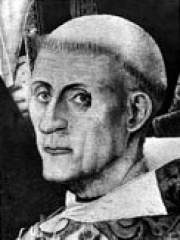
5. Bernt Notke (1435 - 1509)
With an HPI of 66.25, Bernt Notke is the 5th most famous German Artist. His biography has been translated into 19 different languages.
Bernt Notke (; c. 1440 – before May 1509) was a late Gothic artist from the Baltic region. He has been described as one of the foremost artists of his time in northern Europe.

6. Méret Oppenheim (1913 - 1985)
With an HPI of 65.27, Méret Oppenheim is the 6th most famous German Artist. Her biography has been translated into 29 different languages.
Meret (or Méret) Elisabeth Oppenheim (6 October 1913 – 15 November 1985) was a German-born Swiss Surrealist artist and photographer.

7. John Heartfield (1891 - 1968)
With an HPI of 64.95, John Heartfield is the 7th most famous German Artist. His biography has been translated into 29 different languages.
John Heartfield (born Helmut Herzfeld; 19 June 1891 – 26 April 1968) was a German visual artist who pioneered the use of art as a political weapon. Some of his most famous photomontages were anti-Nazi and anti-fascist statements. Heartfield also created book jackets for book authors, such as Upton Sinclair, as well as stage sets for contemporary playwrights, such as Bertolt Brecht and Erwin Piscator.

8. Ulay (1943 - 2020)
With an HPI of 64.75, Ulay is the 8th most famous German Artist. His biography has been translated into 20 different languages.
Frank Uwe Laysiepen (German: [fʁaŋk ˈʔuːvə laɪˈziːpm̩]; 30 November 1943 – 2 March 2020), known professionally as Ulay, was a German artist based in Amsterdam and Ljubljana, who received international recognition for his Polaroid art and collaborative performance art with longtime companion Marina Abramović.

9. Marianne Brandt (1893 - 1983)
With an HPI of 63.90, Marianne Brandt is the 9th most famous German Artist. Her biography has been translated into 24 different languages.
Marianne Brandt (1 October 1893 – 18 June 1983) was a German painter, sculptor, photographer, metalsmith, and designer who studied at the Bauhaus art school in Weimar and later became head of the Bauhaus Metall-Werkstatt (Metal Workshop) in Dessau in 1928. Today, Brandt's designs for household objects such as lamps and ashtrays are considered timeless examples of modern industrial design. Although she pursued painting early in life and attended a private art school and the Grand Ducal College of Art in Weimar from 1911–1917, where she produced many works in the Expressionists style and also studied sculpture, the artist is best known for her sleek and elegant industrial designs.Brandt also worked with photography at the Bauhaus, taking photographs that featured unusual angles—in particular, self-portraits—and disorienting and distorting reflections in glass and metal surfaces.She worked as head of the design department of the company Ruppelwerk Metallwarenfabrik GmbH in Gotha until 1932. In 1949, she worked at the University of Applied Arts (now the Berlin Weißensee School of Art) until 1954. In the year, 1954 she also supervised the exhibition The German applied art of the GDR in Beijing and Shanghai in 1953–54. She also created photomontages.
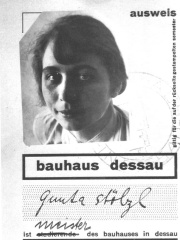
10. Gunta Stölzl (1897 - 1983)
With an HPI of 59.67, Gunta Stölzl is the 10th most famous German Artist. Her biography has been translated into 17 different languages.
Gunta Stölzl (5 March 1897 – 22 April 1983) was a German textile artist who played a fundamental role in the development of the Bauhaus school's weaving workshop, where she created enormous change as it transitioned from individual pictorial works to modern industrial designs. She was one of a small number of female teachers on the Bauhaus' staff and the first to hold the title of "Master". Her textile work is thought to typify the distinctive style of Bauhaus textiles. She joined the Bauhaus as a student in 1919, became a junior master in 1927. She was dismissed for political reasons in 1931, two years before the Bauhaus closed under pressure from the Nazis. The textile department was a neglected part of the Bauhaus when Stölzl began her career, and its active masters were weak on the technical aspects of textile production. She soon became a mentor to other students and reopened the Bauhaus dye studios in 1921. After a brief departure, Stölzl became the school's weaving director in 1925 when it relocated from Weimar to Dessau and expanded the department to increase its weaving and dyeing facilities. She applied ideas from modern art to weaving, experimented with synthetic materials, and improved the department's technical instruction to include courses in mathematics. The Bauhaus weaving workshop became one of its most successful facilities under her direction.
People
Pantheon has 11 people classified as German artists born between 1435 and 1943. Of these 11, none of them are still alive today. The most famous deceased German artists include Hans Holbein the Younger, Joseph Beuys, and Kurt Schwitters.
Deceased German Artists
Go to all RankingsHans Holbein the Younger
1497 - 1545
HPI: 75.75
Joseph Beuys
1921 - 1986
HPI: 73.86
Kurt Schwitters
1887 - 1948
HPI: 69.20
Josef Albers
1888 - 1976
HPI: 68.31
Bernt Notke
1435 - 1509
HPI: 66.25
Méret Oppenheim
1913 - 1985
HPI: 65.27
John Heartfield
1891 - 1968
HPI: 64.95
Ulay
1943 - 2020
HPI: 64.75
Marianne Brandt
1893 - 1983
HPI: 63.90
Gunta Stölzl
1897 - 1983
HPI: 59.67
Daniel Hopfer
1470 - 1536
HPI: 56.19
Overlapping Lives
Which Artists were alive at the same time? This visualization shows the lifespans of the 8 most globally memorable Artists since 1700.

